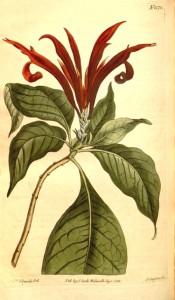Aphelandra pulcherrima (Jacq.) Kunth
Frost tender, rather straggling, evergreen shrub with attractive glossy, large and drooping oblong leaves and 3-sided spikes of showy scarlet flowers. [RHSD, Hortus].
Horticultural & Botanical History
This striking shrub has been known to botanists for more than 250 years and was first botanically described as Justicia pulcherrima by Jacquin [Jacquin ESP 11/1760]. It was placed in the new genus of Aphelandra by Robert Brown in 1812 [Hort.Kew. ed.2, 4: 55/1812] with the specific epithet cristata, but correctly named Aphelandra pulcherrima by Kunth in 1818 [Nov.Gen.Sp. 2: 236/1818]. As seen by the number of synonyms this variable plant was described under a number of names in the succeeding decades but was known as Aphelandra cristata throughout most of the 19th century. This species and its 40 or so recognised variants is today often described as the Aphelandra pulcherrima complex.
‘Aphelandra cristata grows into a handsome tall shrub, which, when covered with its fulgid blossoms, must be a beautiful object. In native specimens, the spikes more generally come out two or four together, not singly, as in our drawing. Found in the West-India islands as well as on the continent, and was introduced to this country by Lord Seaforth.’ [BM t.1578/1813]. ‘It has been almost a century in our gardens, and yet is now scarcely ever seen in any but Botanical collections, where, if it flowers, it generally produces its blossoms so sparingly that those who cultivate it are dissapointed in the expectations they had formed.’ [BR f.1477/1832]. Introduced to Britain in 1733. [JD]. ‘Aphelandra cristata is one of those old plants which, while any person will befriend it by furnishing the soil and atmosphere it loves, will never be permanently disgraced or discarded. And yet the places are by no means scarce in which, through an imperfect knowledge of its sterling characteristics, an ill-disguised indifference, arising from the length of time it has been a denizen of our stoves, and that neglect which must inevitably result from these concurrent causes, it is to be seen in a shabby and stunted state, totally at variance with the healthy condition it maintains under congenial culture.’ [MB p.173/1840]. ABR pl.506/1808.
History at Camden Park
Listed only in the 1857 catalogue [T.60/1857]. Aphelandra cristata was included among desiderata in a letter to John Lindley dated 15th February, 1848, although it was not recorded as ‘arrived’ in Macarthur’s copy [MP A2933-1, p.157]. It was requested of Lindley again on 1st February, 1849 [MP A2933-1, p.182a]. Aphelandra sps. were also requested from Kew at this time but not recorded as arrived [MP A2933-1, p.165]. It was requested again on 1st February, 1849 [MP A2933-1, p.177]. Plants of A. cristata were obtained from the Sydney Botanic Garden on 17th October 1853 and this is the most likely source of the catalogue plants. [RBGS AB].
Notes
Aphelandra cristata H.B. & K. (1815) = Aphelandra pectinata Willd. Ex Nees, a South American species.
Published Feb 25, 2009 - 03:08 PM | Last updated Aug 18, 2010 - 05:56 PM
| Family | Acanthaceae |
|---|---|
| Category | |
| Region of origin | Caribbean and South America |
| Synonyms |
|
| Common Name | |
| Name in the Camden Park Record | Aphelandra cristata |
| Confidence level | high |
